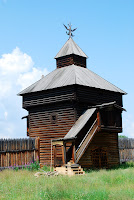With Italy's conquest of Libya and Cyrenaica from 1911 on and its attempt to transform them into Italian colonies, the need to protect this region's exposed southern desert flanks, where nomadic raiders and restive Senussi could move free from Italian interference, grew increasingly evident. A string of forts was established across the arid landscape and their controlling presence amplified by desert patrols using first camels and, later on, motorized vehicles. Making Italian presence felt even in the deep desert required that the important oasis and caravan town of Kufra be conquered by an expeditionary force in 1931.
The open desert landscape of Cyrenaica and Libya was the roaming ground of the Compagnia Sahariana, which was first formed to impose order within a colonial context. After the move was made from camels to motorized vehicles, these mechanized companies became known as Companie Auto-Avio Sahariane. With the onset of war in the Western Desert, these units became an important resource for countering the British Long Range Desert Group's efforts to turn the southern flanks of the Italian armies through deep penetrating moves across the desert. One company deploying the AS 37, the most important vehicle used, played a role in the failed Italian effort to defend Kufra against the Free French forces (aided by the LRDG) that came up from Chad in 1941. From 1942-43, a new vehicle custom-designed by Viberti for desert patrolling was introduced and placed into service: the AS 42.
Eventually, I would like to build an
Autosahariana platoon using a mix of AS 37 and AS 42 vehicles.
I started this project with two AS 42 Saharianas that I built from the Italeri 1/72 kit a few years back. I converted various 1/76 figures to make a crew for them and also replaced 20mm Breda modello 35 with an Ansaldo-Bohler 47/32 gun taken from the Waterloo 1815 Folgore artillery set. The painting is still a little crude and I do need to go back to clean up, weather more and add details.

There will be more to come later, I hope. You see here a MMS 1/76 Fiat AS37 with a 20mm Breda modello 35 on the bed.






















































